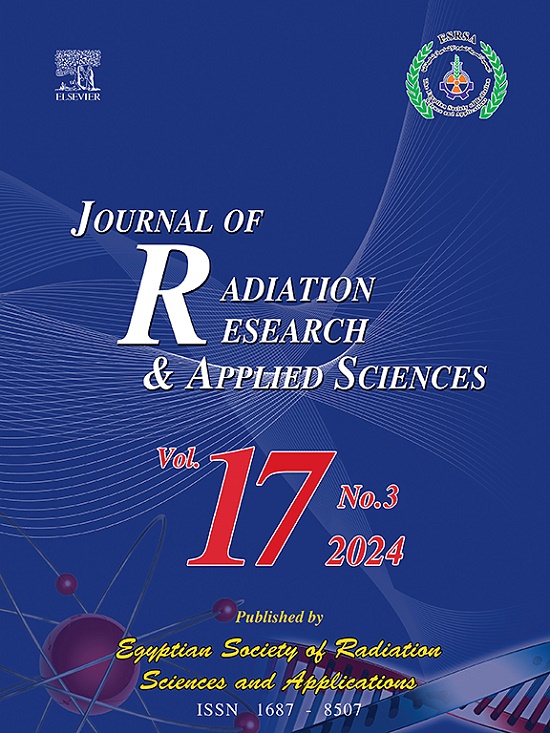Evaluation of photon shielding properties and exposure buildup factors for various clay using Geant4 simulation and WinXCOM
IF 1.7
4区 综合性期刊
Q2 MULTIDISCIPLINARY SCIENCES
Journal of Radiation Research and Applied Sciences
Pub Date : 2025-03-22
DOI:10.1016/j.jrras.2025.101409
引用次数: 0
Abstract
Radiation shielding is an essential component for any radiation equipment and sites. In this study, Geant4 was used to simulate the mass attenuation coefficients (MACs) of nine clay, pink granite, sandstone and concrete under five gamma radioactive sources (22Na, 54Mn, 57Co, 60Co, and 137Cs). Key shielding parameters, including the mean free path, half-value layer, radiation protection efficiency (RPE), and effective atomic number were calculated based on MACs. The simulated values were validated against the theoretical values of WinXCOM, with relative deviations ranging from −0.6% to +0.85%, demonstrating the reliability of Geant4 in evaluating the photon shielding ability. The exposure buildup factors were also calculated using the G-P fitting method, revealing a peak around 0.15 MeV and a penetration depth of 40 mfp. It depends on the incident photon energy, the penetration depth, the composition of the material and the photon interaction mechanism. Results of simulations and theoretical calculations show that bentonite and vermiculite have the best photon shielding performance at low and intermediate photon energies, while kaolinite and ball clay have the worst photon shielding properties. All clay with a thickness of 20 cm are sufficient to attenuate more than 99.7% of the incident photons from 57Co and more than 90% of the incident photons from the other four radioactive sources. Compared to traditional shielding materials (concrete and sandstone), these clay provide comparable or superior shielding effectiveness, with RPE differences within ±6%. This study offers a theoretical basis for using clay as suitable, cost-effective alternatives for radiation shielding, with potential applications in nuclear safety, medical radiation protection, and space radiation shielding.
利用Geant4模拟和WinXCOM评价不同粘土的光子屏蔽性能和曝光积累因素
辐射屏蔽是任何辐射设备和场所的基本组成部分。本研究利用Geant4模拟了5种γ辐射源(22Na、54Mn、57Co、60Co和137Cs)对9种粘土、粉色花岗岩、砂岩和混凝土的质量衰减系数(MACs)。基于MACs计算了平均自由程、半值层、辐射防护效率(RPE)和有效原子序数等关键屏蔽参数。模拟值与WinXCOM的理论值进行了对比,相对偏差在−0.6% ~ +0.85%之间,证明了Geant4在评估光子屏蔽能力方面的可靠性。利用G-P拟合方法计算了暴露累积因子,发现峰值在0.15 MeV左右,穿透深度为40 mfp。它取决于入射光子的能量、穿透深度、材料的组成和光子相互作用机理。模拟和理论计算结果表明,膨润土和蛭石在中低光子能量下的光子屏蔽性能最好,高岭土和球粘土的屏蔽性能最差。所有厚度为20 cm的粘土都足以衰减来自57Co的99.7%以上的入射光子和来自其他四个放射源的90%以上的入射光子。与传统的屏蔽材料(混凝土和砂岩)相比,这些粘土提供了相当或更好的屏蔽效果,RPE差异在±6%以内。该研究为利用粘土作为合适的、具有成本效益的辐射屏蔽替代品提供了理论基础,在核安全、医疗辐射防护和空间辐射屏蔽方面具有潜在的应用前景。
本文章由计算机程序翻译,如有差异,请以英文原文为准。
求助全文
约1分钟内获得全文
求助全文
来源期刊

Journal of Radiation Research and Applied Sciences
MULTIDISCIPLINARY SCIENCES-
自引率
5.90%
发文量
130
审稿时长
16 weeks
期刊介绍:
Journal of Radiation Research and Applied Sciences provides a high quality medium for the publication of substantial, original and scientific and technological papers on the development and applications of nuclear, radiation and isotopes in biology, medicine, drugs, biochemistry, microbiology, agriculture, entomology, food technology, chemistry, physics, solid states, engineering, environmental and applied sciences.
 求助内容:
求助内容: 应助结果提醒方式:
应助结果提醒方式:


